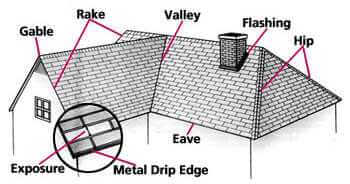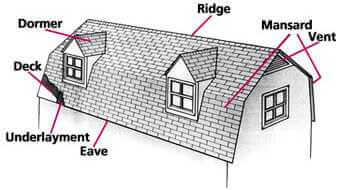Philadelphia and South New Jersey Roofing FAQ’s
Below are some standard definitions regarding roofing issues. These are common terms used in the northeast on homes in New Jersey and Pennsylvania. Hopefully, you can use these terms when you are trying to figure out what is wrong with your roof or what you are looking to get fixed. We look forward to hearing from you – please call us for a free estimate.

Algae discoloration: A type of roof discoloration caused by algae. Commonly called fungus growth.
Base flashing: That portion of the flashing attached to or resting on the deck to direct the flow of water onto the roof covering.
Blisters: Bubbles that may appear on the surface of asphalt roofing after installation.
Butt: The larger, exposed end of a shingle.
Coverage: Amount of weather protection provided by the roofing material. Depends on number of layers of material between the exposed surface of the roofing and the deck; i.e., single coverage, double coverage, etc.
Cricket: A wood-framed structure that diverts water away from chimneys, walls or other vertical roof projections and penetrations; also called a saddle.
Deck: Plywood or oriented strand board (OSB) sheathing used as a base for securing roofing materials.
Dormer:A small structure projecting from a sloped roof, usually with a window.
Drip edge: An L-shaped metal strip positioned along a roof’s edges to allow water to run off the roof without running down eaves or siding.
Eaves: On a sloped roof, the horizontal underside that projects out from the house wall.
Exposure: The part of a shingle that is exposed to the weather, usually less than half its actual length.
Fascia: Vertical roof trim located along the perimeter of a building, usually below the roof level, to cover the rafter tails at the eaves. Also called the boards behind the gutter.
Felt/Deck Armor underlayment: Asphalt-impregnated roofing paper that creates a secondary, watertight barrier between many roofing products and the roof deck.
Fire rating: System for classifying the fire resistance of various materials. Roofing materials are rated Class A, B or C, with Class A materials having the highest resistance to fire originating outside the structure.
Flashing: Metal pieces that keep water from seeping into intersections, such as valleys or joints at vertical walls, or around roof penetrations, such as chimneys or vent pipes.

Flat or low slope roof: A roof with a pitch of less than three feet of rise over a twelve-foot run; this type of roof needs a sealed system installation.
Gutter: The trough that channels water from the eaves to the downspouts.
Hip: The external angle formed by the intersection of two sloping roof planes; from the ridge to the eaves.
Ice/Leak barrier: A self-adhering and self-healing membrane applied to the roof deck and designed to protect against water infiltration from ice buildup or wind-driven rain.
Laminated shingles: Strip shingles made with fiberglass mat and asphalt that are laminated, or textured, to create a three-dimensional effect. Also called dimensional or architectural shingles. There are also shingles that are called dimensional though they are made from a single material, not two materials laminated together.
Louver: Slatted devices installed in a gable or soffit (the underside of eaves) to ventilate the space below a roof deck and equalize air temperature and moisture.
Overhang: That portion of the roof structure that extends beyond the exterior walls of a building.
Ply: The number of layers of roofing: i.e. one-ply, two-ply.
Pitch: Roof slope expressed as the ratio of a roof’s rise (vertical distance) to each foot of run (horizontal distance). A “4-in-12 pitch” means the roof rises 4 inches for every 12 inches of horizontal distance.
Plumbing boot: A prefabricated covering, usually of flexible material, used to seal around a penetration; also called a pipe flange or roof jack.
Rafters: The framework that supports the roof deck and roofing. On a sloped roof, these are the angled timbers on the underside.
Rake: The sloped edge of a roof over a wall.
Ridge: The peak where two sloped roof sections meet.
Ridge vent: A type of roof exhaust vent that ventilates the attic along the ridge or hip line where the roof deck has been cut back; works in conjunction with soffit vents under the eaves.
Roof ventilation: A static, wind- or power-operated system for removing hot air and moisture from the air under your roof. Includes ridge vents.
Sheathing: The boards or sheet materials that are fastened to rafters to cover a house or building.
Shed roof: A roof containing only one sloping plane; a single-pitch roof, with no hips, ridges, valleys or gables. Also called a half gable. The area at the top is called a clearstory, or clerestory.
Slope: Measured by rise in inches for each 12 inches of horizontal run: A roof with a 4-in-12 slope rises 4 inches for every foot of horizontal distance.
Soffit: The finished underside of the eaves, or roof overhang, which can be enclosed or exposed.
Soffit vent: An intake vent in the soffit area of the house that provides attic venting at a lower portion of the roof deck and good circulation with other forms of venting such as ridge or roof vents.
Square: A measurement of roof area that equals 100 square feet (an area 10′ by 10′).
Valley: The angle formed where two sloping roof surfaces intersect.
Water shield: A watertight barrier used to seal water out at the eaves and rakes, in valleys, and around chimneys and skylights.
Areas Serviced: South East New Jersey, South West New Jersey.
Please call us for a free estimate on any roof, gutter, siding, door or window project your are considering. We will provide you with a written estimate and our services are not only guaranteed but we will be very competitively priced. Call us today! (856) 303-0945



